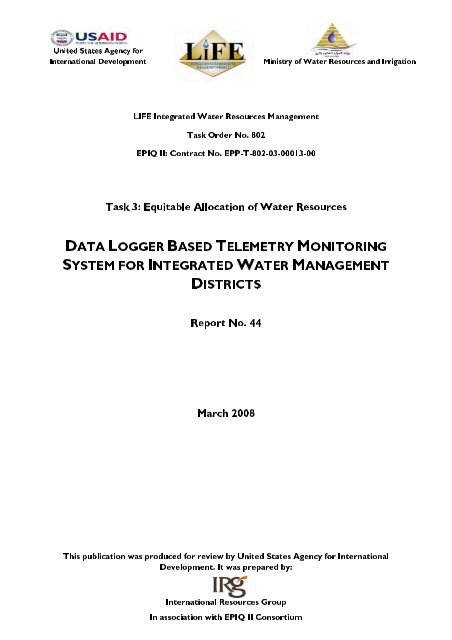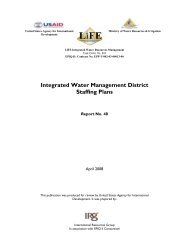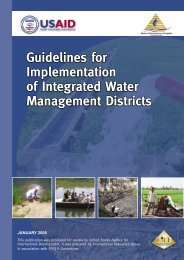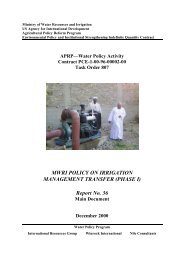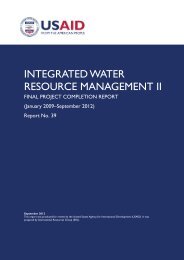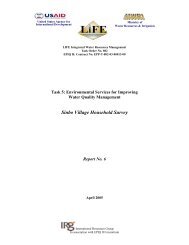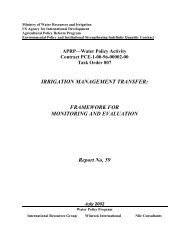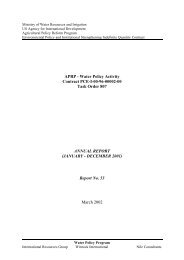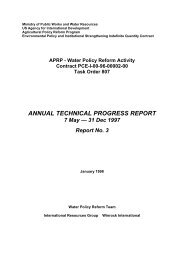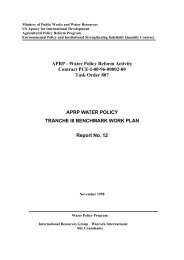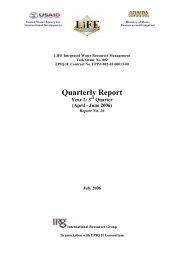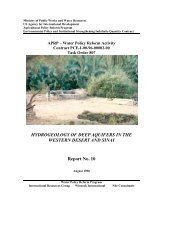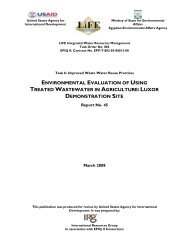Report 44 Task 3 Data Logger Telemetry System
Report 44 Task 3 Data Logger Telemetry System
Report 44 Task 3 Data Logger Telemetry System
You also want an ePaper? Increase the reach of your titles
YUMPU automatically turns print PDFs into web optimized ePapers that Google loves.
publication was produced for review by United States Agency for International<br />
This<br />
It was prepared by:<br />
Development.<br />
United States Agency for<br />
International Development<br />
Ministry of Water Resources and Irrigation<br />
LIFE Integrated Water Resources Management<br />
<strong>Task</strong> Order No. 802<br />
EPIQ II: Contract No. EPP-T-802-03-00013-00<br />
<strong>Task</strong> 3: Equitable Allocation of Water Resources<br />
DATA LOGGER BASED TELEMETRY MONITORING<br />
SYSTEM FOR INTEGRATED WATER MANAGEMENT<br />
DISTRICTS<br />
<strong>Report</strong> No. <strong>44</strong><br />
March 2008<br />
International Resources Group<br />
In association with EPIQ II Consortium
US Agency<br />
Ministry of Water Resources<br />
and Irrigation<br />
for International Development<br />
LIFE Integrated Water Resources Management<br />
<strong>Task</strong> Order No. 802<br />
EPIQ II: Contract No. EPP-T-802-03-00013-00<br />
<strong>Task</strong> 3: Equitable Allocation of Water Resources<br />
DATA LOGGER BASED TELEMETRY MONITORING<br />
SYSTEM FOR INTEGRATED WATER MANAGEMENT<br />
DISTRICTS<br />
<strong>Report</strong> No. <strong>44</strong><br />
Prepared by:<br />
Eng. Ibrahim Mahdy Sallam<br />
Eng. Ayman ElSayed Ibrahim<br />
March 2008<br />
DISCLAIMER<br />
The authors views expressed in this publication do not necessarily reflect the views of the United<br />
States Agency for International Development or the United States Government
of Figures and Tables...........................................................................................................ii<br />
List<br />
Figures...................................................................................................................................................................ii<br />
<strong>Data</strong> Summary..................................................................................................................... 4<br />
4.<br />
Preparation and Equipment ......................................................................................................................5<br />
Site<br />
Lesson Learned .................................................................................................................. 15<br />
8.<br />
of Operation Policy at Mealla Pump Station.............................................................................. 15<br />
Revision<br />
Policy Evaluation at East Menofiya Pump Station.................................................................. 15<br />
Operation<br />
<strong>Data</strong> and Downstream Sites .................................................................................................... 16<br />
Monitoring<br />
to Integrated Water Management and Conflict Resolution.................................................. 16<br />
Supports<br />
<strong>Data</strong> Supports Planning .................................................................................................................... 17<br />
<strong>System</strong><br />
Supports Ministry’s Plans for the <strong>Telemetry</strong> <strong>System</strong> ................................................................. 17<br />
<strong>System</strong><br />
Supports Integrated Water Management during Crises ........................................................... 17<br />
<strong>System</strong><br />
Confidence of the <strong>System</strong> .................................................................................................................... 17<br />
High<br />
Supports Water Quality Management and Drainage Water Reuse ....................................... 17<br />
<strong>System</strong><br />
1 <strong>Logger</strong> Net Software Operation ..................................................................... 27<br />
Annex<br />
Net Setting .......................................................................................................................................... 27<br />
<strong>Logger</strong><br />
GSM Modem Connection............................................................................................................... 29<br />
SAMBA<br />
of TANGO GSM Modem with CR510 <strong>Logger</strong>................................................................... 30<br />
Connection<br />
3 Maintenance Forms ......................................................................................... 37<br />
Annex<br />
<strong>Logger</strong> Scheduled Maintenance Form................................................................................................ 37<br />
<strong>Data</strong><br />
Modem Maintenance Form ............................................................................................................... 39<br />
Tango<br />
Supply Scheduled Maintenance Form............................................................................................. 40<br />
Power<br />
<strong>Task</strong> 3. <strong>Data</strong> <strong>Logger</strong> Based <strong>Telemetry</strong> Monitoring <strong>System</strong><br />
TABLE OF CONTENTS<br />
Tables ....................................................................................................................................................................ii<br />
Acronyms and Abbreviations....................................................................................................iii<br />
1. Introduction ......................................................................................................................... 1<br />
2. Implementation Strategy ................................................................................................... 2<br />
3. Pilot Project Sites................................................................................................................ 3<br />
5. <strong>Data</strong> Management ............................................................................................................. 10<br />
6. <strong>System</strong> Evaluation ............................................................................................................. 13<br />
7. <strong>System</strong> Benefits ................................................................................................................. 14<br />
9. <strong>System</strong> installation and Operation Cost......................................................................... 18<br />
10. Problems Encountered ..................................................................................................... 19<br />
11. Site Photos ......................................................................................................................... 20<br />
12. Recommended Preventive Maintenance Schedule ....................................................... 24<br />
13. Recommendations and Future Plan ................................................................................ 26<br />
Annex 2 <strong>Logger</strong> NET ....................................................................................................... 31<br />
LIFE IWRM i INTERNATIONAL RESOURCES GROUP
<strong>Task</strong> 3. <strong>Data</strong> <strong>Logger</strong> Based <strong>Telemetry</strong> Monitoring <strong>System</strong><br />
LIST OF FIGURES AND TABLES<br />
Figures<br />
Figure 1 Installed Monitoring Components....................................................................................... 5<br />
Figure 2 Remote <strong>Data</strong> <strong>Logger</strong> Sites in Qena Directorate ............................................................. 6<br />
Figure 3 <strong>Data</strong> <strong>Logger</strong>s Sites in West and East Sharkiya Directorates......................................... 7<br />
Figure 4 <strong>Data</strong> <strong>Logger</strong> Sites in Zifta Directorate ............................................................................... 8<br />
Figure 5 <strong>Data</strong> <strong>Logger</strong> Sites in Aswan Directorate ............................................................................... 9<br />
Figure 6<br />
User Main Menu.....................................................................................................................11<br />
Figure 7 MIMIC Display for Mealah PS <strong>Data</strong> ...................................................................................12<br />
Figure 8 Table Displaying Mealah PS <strong>Data</strong> .......................................................................................12<br />
Figure 9 Downstream Water Levels, Meaala PS, 11 June–17 July, 2007......................................15<br />
Figure 10 East Menofiya PS Upstream Water Level and Conductivity, 17–21 July, 2007........16<br />
Figure 11 Ghawasa Regulator USWL & DSWL, 25 June–5 July 2007...................................16<br />
Figure 12 Meit Bera Regulator .........................................................................................................20<br />
Figure 13<br />
Meit Bera Regulator’s <strong>Data</strong> <strong>Logger</strong> and GSM Modem Connection with RTU.21<br />
Figure 14 Meala PS Relay Enclosure, <strong>Data</strong> <strong>Logger</strong> and GSM Modem Connection .............21<br />
Figure 15 Meala PS Local Warning <strong>System</strong> and Installed Siren ................................................22<br />
Figure 16 Ghawasa Regulator Installed Equipment .....................................................................22<br />
Figure 17 Ghawasa Regulator Installed Sensor Pipes .................................................................23<br />
Tables<br />
Table 1<br />
Monitored <strong>Data</strong> by Location............................................................................................................4<br />
Table 2<br />
Recommended Maintenance Schedule........................................................................................24<br />
LIFE IWRM ii INTERNATIONAL RESOURCES GROUP
<strong>Task</strong> 3. <strong>Data</strong> <strong>Logger</strong> Based <strong>Telemetry</strong> Monitoring <strong>System</strong><br />
ACRONYMS AND ABBREVIATIONS<br />
DO<br />
Dissolved Oxygen<br />
DSWL Downstream Water Level<br />
GMS<br />
Global <strong>System</strong> for Mobile communications<br />
GPRS<br />
General Packet Radio Service<br />
IP<br />
Internet Provider<br />
IWMD Integrated Water Management District<br />
km<br />
Kilometer<br />
LE<br />
Egyptian Pounds (currency)<br />
LIFE<br />
Livelihood and Income from the Environment (Project)<br />
MIMIC Display Panel<br />
MWRI Ministry of Water Resources and Irrigation<br />
PDA<br />
Personal Digital Assistant (computing)<br />
pH<br />
Measure of acidity or alkalinity<br />
PS<br />
Pumping Station<br />
RTU<br />
Remote Terminal Unit<br />
SMS<br />
Short Message Service<br />
USAID United States Agency for International Development<br />
USWL Upstream Water Level<br />
VHF<br />
Very High Frequency<br />
LIFE IWRM iii INTERNATIONAL RESOURCES GROUP
document describes the pilot project for implementing a data logger-based telemetry system to<br />
This<br />
inflows and outflows of the Integrated Water Management Districts (IWMDs). The main<br />
monitor<br />
of the implemented pilot project was to strengthen the capabilities of the IWMDs’<br />
purpose<br />
staff to monitor and analyze water. distribution The system was implemented at eleven<br />
operations<br />
structures and pumping stations. At irrigation structures, the system provided real or near<br />
irrigation<br />
time information on water levels and flows. At the pumping stations, in addition to monitoring<br />
real<br />
level data, the system monitored changes in pump status, operating hours, and flow. The pilot<br />
water<br />
included monitoring water quality parameters (pH, conductivity, and dissolved oxygen) at<br />
project<br />
sites. Moreover, a local warning system was included in the pilot project at one pumping<br />
some<br />
site, in addition to a short message service- (SMS) based warning system.<br />
station<br />
data will help in calculating water flow volumes at major inflow and outflow points, in order to<br />
The<br />
water quotas for each district and achieve enhanced water management. Having these data<br />
monitor<br />
in real time will be of great benefit in achieving integrated water management. The system<br />
available<br />
data loggers equipped with GSM modems at irrigation structures and pumping stations. The data<br />
uses<br />
<strong>Task</strong> 3. <strong>Data</strong> <strong>Logger</strong> Based <strong>Telemetry</strong> Monitoring <strong>System</strong><br />
1. INTRODUCTION<br />
can be downloaded at IWMDs offices using another GSM modem.<br />
LIFE IWRM 1 INTERNATIONAL RESOURCES GROUP
order to minimize the capital cost, the Ministry of Water Resources and Irrigation’s (MWRI)<br />
In<br />
telemetry network was utilized to serve this pilot project. The MWRI already has a<br />
existing<br />
system that monitors water level data and uses VHF as the communication media. The<br />
telemetry<br />
is complicated in its structure. Moreover, the performance of this old system is not<br />
system<br />
partly due to the long path of data, VHF interference, and faulty equipment at the end of<br />
satisfactory,<br />
useful life.<br />
its<br />
pilot system uses the existing infrastructure of the telemetry network. The existing water levels,<br />
The<br />
conduits, batteries, solar panels, solar regulators, and civil construction were used following<br />
cables,<br />
maintenance. A data logger with sufficient input and output was connected to water level<br />
minor<br />
The solar panel and battery were used to provide continuous power to the low power<br />
sensors.<br />
data logger. The new equipment, data logger, and GSM modem were installed inside<br />
consumption<br />
same box from the existing telemetry system.<br />
the<br />
existing water level sensors were connected to the data logger. The data logger continuously<br />
The<br />
measured data from the sensors. This data could be provided to any remote location in a real<br />
read<br />
sense. The data logger also stored measured data according to predefined intervals with a<br />
time<br />
of 1 minute. The stored data could be downloaded remotely at any time by the GSM<br />
resolution<br />
The time resolution used in this project was an hour, which meant that data loggers stored<br />
network.<br />
readings from all sensors and saved the data to a file.<br />
hourly<br />
pilot project achieved another important planned objective related to evaluating MWRI plans to<br />
The<br />
the existing telemetry system. The Ministry, with support from the United States Agency<br />
renovate<br />
International Development (USAID), invested a lot of money in the telemetry network in early<br />
for<br />
USAID supplied US$56 million to implement the network throughout the country’s irrigation<br />
1990s.<br />
Recently the performance of the telemetry system became unsatisfactory and its support<br />
networks.<br />
water management was diminishing. The Ministry has been studying renovating approaches to get<br />
to<br />
system in service again to make use of the earlier investment. The pilot showed that the existing<br />
the<br />
can be renovated at a very small capital investment.<br />
network<br />
equipment was chosen to achieve reliable operation and accuracy, be low in power<br />
The<br />
and be compatible with the latest technologies in the field of communication and<br />
consumption,<br />
systems. <strong>System</strong> features include accuracy, simplicity, reliability, and flexibility. Accuracy<br />
electronic<br />
achieved as a result of precise data logger acquisition capability. The compact size of the<br />
was<br />
and its ease of use make the system simple. Reliability is achieved with the outstanding<br />
equipment<br />
and low power consumption of the data logger. The flexibility of the system operation<br />
performance<br />
different ways to collect data. The data stored hourly could be collected using three different<br />
allows<br />
methods:<br />
Direct connection, using a Personal Digital Assistant (PDA) or laptop computer<br />
•<br />
Using a memory module<br />
•<br />
Remotely, using a GSM modem.<br />
•<br />
could be monitored and collected from any IWMD or irrigation directorate office using a GSM<br />
<strong>Data</strong><br />
network. During the past years, the system gave excellent performance and<br />
communication<br />
accurate measures of water levels and flows. The stored and collected data is useful not<br />
provided<br />
for daily system operation but also for system planning. Operation policies for irrigation<br />
only<br />
are being revised based on these data. The water level monitoring network ensures that<br />
structures<br />
needs are met. The data collected at pumping stations helped to solve conflicts between the<br />
water<br />
<strong>Task</strong> 3. <strong>Data</strong> <strong>Logger</strong> Based <strong>Telemetry</strong> Monitoring <strong>System</strong><br />
2. IMPLEMENTATION STRATEGY<br />
irrigation directorates and the mechanical and electrical directorates.<br />
LIFE IWRM 2 INTERNATIONAL RESOURCES GROUP
sites of the pilot project were carefully selected. All the sites are critical and have a major effect<br />
The<br />
water management, with an essential need for monitoring near real time data as most of them<br />
on<br />
water distribution problems. The site selection criteria helped in evaluating the<br />
encounter<br />
of the system and identifying achieved goals. At all selected sites the upstream and<br />
performance<br />
water levels and water flows are monitored. Water quality parameters are monitored<br />
downstream<br />
two sites. The pump monitoring system was installed at two sites. The pilot project is<br />
at<br />
Abou el-Akhadr Regulator<br />
•<br />
Meit Bera Regulator<br />
•<br />
Meluig Regulator<br />
•<br />
Hebeil Regulator<br />
•<br />
El-Ghawasa Regulator<br />
•<br />
Ismailia Intake<br />
•<br />
Mealaa Pumping Station (PS)<br />
•<br />
East Menofiya PS<br />
•<br />
El Selsala PS.<br />
•<br />
Daraw Regulator<br />
•<br />
GSM mobile communication network provided flexibility for data collection. <strong>Data</strong> can be<br />
The<br />
from any remote location provided that it is covered by the mobile network. The data<br />
collected<br />
be collected at the irrigation directorate office, or a water distribution engineer could use a<br />
might<br />
to collect data in the field. For now, the data are monitored at different levels from the<br />
laptop<br />
Berket el-Saab IWMD<br />
•<br />
Luxor IWMD<br />
•<br />
Zifta General Directorate<br />
•<br />
East Sharkiya General Directorate<br />
•<br />
West Sharkiya General Directorate<br />
•<br />
East Qena General Directorate<br />
•<br />
Aswan Directorate.<br />
•<br />
Aswan IWMD<br />
•<br />
Lower Egypt Water Distribution Directorates at Tanta<br />
•<br />
Central Directorate for <strong>Data</strong> Collection and Communication <strong>Telemetry</strong><br />
•<br />
The Livelihood and Income from the Environment (LIFE) Integrated Water<br />
•<br />
<strong>Task</strong> 3. <strong>Data</strong> <strong>Logger</strong> Based <strong>Telemetry</strong> Monitoring <strong>System</strong><br />
3. PILOT PROJECT SITES<br />
at the following sites:<br />
implemented<br />
Kilometer (km) 24 on Mous Regulator<br />
•<br />
locations:<br />
following<br />
Quesna IWMD<br />
•<br />
• El Selsala IWMD<br />
• Central Directorate for Water Distribution at the MWRI Building<br />
Resources Management Project.<br />
LIFE IWRM 3 INTERNATIONAL RESOURCES GROUP
<strong>Task</strong> 3. <strong>Data</strong> <strong>Logger</strong> Based <strong>Telemetry</strong> Monitoring <strong>System</strong><br />
4. DATA SUMMARY<br />
The monitored data includes water levels and water flows, pump status (On/Off), and pump<br />
operating hours. The water quality parameters measured and monitored include pH, dissolved<br />
oxygen, and conductivity. Table 1 describes data monitored by the system at each site:<br />
Table 1<br />
Monitored <strong>Data</strong> by Location<br />
Site Directorate Monitored <strong>Data</strong><br />
km 24 Regulator<br />
East Sharkiya<br />
Upstream Water Level (USWL) –<br />
Downstream Water Level (DWSL) –<br />
West Sharkiya<br />
Water Flow<br />
Abou el-Akhdar<br />
East Sharkiya<br />
USWL-DWSL – Water Flow<br />
Regulator<br />
West Sharkiya<br />
Meit Bera Regulator<br />
Zifta Directorate<br />
USWL-DWSL – Water Flow<br />
Quesna IWMD<br />
Meluig Regulator<br />
Zifta Directorate<br />
USWL-DWSL – Water Flow<br />
Berkt el-Sabaa IWMD<br />
Hebeil Regulator<br />
Qena Directorate<br />
USWL-DWSL – Water Flow<br />
Luxor IWMD<br />
Ghawasa Regulator Qena Directorate USWL-DWSL – Water Flow<br />
Ismailia Intake WD Central Directorate USWL-DWSL – Water Flow – pH –<br />
Dissolved Oxygen (DO) - Salinity -<br />
Water & Air Temperatures<br />
East Menofiya PS<br />
Zifta Directorate<br />
USWL-DWSL – Water Flow – Pump<br />
Status (On/Off) - Pump Operating<br />
Berkt el-Sabaa IWMD<br />
Hours – pH - DO-Salinity – Water & Air<br />
Temperatures<br />
Mealla PS<br />
Qena Directorate<br />
USWL-DWSL-Flow – Pump Status<br />
(On/Off) – Pump Operating Hours<br />
Luxor IWMD<br />
EL Selsala PS<br />
Aswan Directorate<br />
USWL-DWSL-Flow – Pump Status<br />
(On/Off) – Pump Operating Hours<br />
El Selsala IWMD<br />
Daraw Regulator<br />
Aswan Directorate<br />
USWL-DWSL – Water Flow<br />
Aswan IWMD<br />
In additional to the collected data, the pump monitoring system also provides an automatically<br />
activated local/remote warning system in some circumstances. The local warning system has a siren<br />
installed at the pumping station; the remote system is implemented by a GSM SMS. The warning<br />
system is activated if all pumps in a pumping station are switched off.<br />
LIFE IWRM 4 INTERNATIONAL RESOURCES GROUP
• <strong>Data</strong> logger, which serves as the data acquisition system to read sensors hourly,<br />
• GSM/GPRS modem, used for data communication to the site<br />
GSM<br />
Modem<br />
WIRELESS<br />
TELEPHONE<br />
<strong>Task</strong> 3. <strong>Data</strong> <strong>Logger</strong> Based <strong>Telemetry</strong> Monitoring <strong>System</strong><br />
Site Preparation and Equipment<br />
The pilot sites are all existing telemetry sites. Necessary maintenance and civil works were carried<br />
out depending on site condition. Sensor pipes and equipment boxes were renewed and painted. The<br />
sites were supplied with new batteries and water level sensors. and the following equipment were<br />
installed:<br />
record times when pump status changes, and store data on a defined frequency<br />
• New pressure-type water levels sensors and batteries<br />
• Cables and accessories<br />
• Relay enclosure, which was the interface that determined the pump status at the<br />
monitoring sites.<br />
Figure 1 shows the main components of the system at the irrigation structure sites.<br />
Figure 1<br />
Installed Monitoring Components<br />
Battery<br />
GSM Modem<br />
IWMD Office<br />
Water Flow<br />
USWL Sensor<br />
DSWL Sensor<br />
Irrigation Structure<br />
The equipment is connected to the same power source as the existing telemetry system at the<br />
remote sites. The data logger is connected to the existing water level sensors. The system includes<br />
three remote sites in Qena Directorate. The three sites are located in the digital map shown in<br />
Figure 2. Sharkiya’s two data logger sites are shown in Figure 3.<br />
LIFE IWRM 5 INTERNATIONAL RESOURCES GROUP
n<br />
a l<br />
E<br />
lk<br />
Elkallabiya<br />
Intake<br />
Ghawasa<br />
Regulator<br />
Malaa El<br />
Station<br />
Pump<br />
<strong>Task</strong> 3. <strong>Data</strong> <strong>Logger</strong> Based <strong>Telemetry</strong> Monitoring <strong>System</strong><br />
Figure 2<br />
Remote <strong>Data</strong> <strong>Logger</strong> Sites in Qena Directorate<br />
East Qena Directorate<br />
N<br />
ile<br />
ElGhallassy<br />
Intake<br />
<br />
l labiya C<br />
a<br />
El Hebeil Regulator<br />
a<br />
Asna<br />
Bridge<br />
<strong>Data</strong> <strong>Logger</strong> Sites<br />
LIFE IWRM 6 INTERNATIONAL RESOURCES GROUP
Domiata<br />
Barrage<br />
B<br />
r<br />
a<br />
a<br />
it<br />
a<br />
D<br />
o<br />
m<br />
a<br />
it<br />
a<br />
D<br />
o<br />
m<br />
B<br />
r<br />
a<br />
a<br />
y<br />
a<br />
w<br />
f<br />
e<br />
T<br />
a<br />
Mouse<br />
Bahr<br />
Intake<br />
<strong>Task</strong> 3. <strong>Data</strong> <strong>Logger</strong> Based <strong>Telemetry</strong> Monitoring <strong>System</strong><br />
Figure 3<br />
<strong>Data</strong> <strong>Logger</strong>s Sites in West and East Sharkiya Directorates<br />
West Sharqyia Directorate<br />
h<br />
c<br />
n<br />
M 2 4<br />
K<br />
Regulator<br />
Abou<br />
ELakhdar<br />
Bahr Mouse<br />
h<br />
e<br />
k y R<br />
h<br />
c<br />
n<br />
<strong>Data</strong> <strong>Logger</strong> Sites<br />
LIFE IWRM 7 INTERNATIONAL RESOURCES GROUP
R ossi<br />
te Branch<br />
<strong>Task</strong> 3. <strong>Data</strong> <strong>Logger</strong> Based <strong>Telemetry</strong> Monitoring <strong>System</strong><br />
The system also include two sites in Zifta Directorate, shown in figure 4.<br />
Figure 4<br />
<strong>Data</strong> <strong>Logger</strong> Sites in Zifta Directorate<br />
Zifta Directorate<br />
Abbasy Rayah<br />
Gharbyia & Dahtora Drainage<br />
Meluig Regulator<br />
R ayahMonof e<br />
ei Ber a<br />
a t t o r<br />
egul M<br />
R<br />
D amai tia Br a nch<br />
Ismailia Intake<br />
Nile<br />
<strong>Data</strong> <strong>Logger</strong> Sites<br />
LIFE IWRM 8 INTERNATIONAL RESOURCES GROUP
w<br />
n<br />
A<br />
s<br />
C<br />
a<br />
iy<br />
a<br />
a<br />
l<br />
a<br />
E<br />
l<br />
k<br />
C<br />
a<br />
<strong>Task</strong> 3. <strong>Data</strong> <strong>Logger</strong> Based <strong>Telemetry</strong> Monitoring <strong>System</strong><br />
The system also include two sites in Aswan Directorate, shown in figure 5.<br />
Figure 5 <strong>Data</strong> <strong>Logger</strong> Sites in Aswan Directorate<br />
Aswan Directorate<br />
<br />
<br />
b<br />
l<br />
l<br />
a<br />
a<br />
f<br />
n<br />
n<br />
Esna Bridge<br />
Asfwn Intake<br />
Elkallabiya Intake<br />
El Selsala<br />
Pump Station<br />
EL Selsala Canal<br />
N<br />
ile<br />
Daraw Regulator<br />
Daraw<br />
Pump Station<br />
Aswan<br />
Reservoir<br />
High dam<br />
Nasr<br />
Lake<br />
TOSHKA<br />
<strong>Data</strong> <strong>Logger</strong> Sites<br />
LIFE IWRM 9 INTERNATIONAL RESOURCES GROUP
data collected hourly by the data logger is stored in a file on non-volatile memory. The data<br />
The<br />
storage capacity can handle up to 2 years’ worth of water level and water flow data. The<br />
logger’s<br />
personal computer loaded with data collection software and a GSM modem are the only<br />
A<br />
needed for data collection at the directorate or district offices. The data is collected by<br />
equipment<br />
the GSM number at the site from the computer. Once the connection between the data<br />
dialing<br />
and the computer is established, data can be downloaded to the computer.<br />
logger<br />
major advantage of the system is that the format of the data is chosen in a way that does not<br />
One<br />
too much space. For example, a single year’s water level data for a site is stored in a file of a<br />
take<br />
hundred kilobytes. Moreover, the compact size of the data not only saves disk space but also<br />
few<br />
GSM collection time, which in turns saves connection costs. Future plans call for use of GPRS<br />
saves<br />
its launching last year, the system has been running and working well. The system provides<br />
Since<br />
and continuous data to the district and directorate offices. With a goal to extend system<br />
accurate<br />
to more users and support the central levels, data collection software was installed at the<br />
benefits<br />
Directorate for Water Distribution in the MWRI building and at the Lower Egypt Water<br />
Central<br />
district and directorate office has a software package that allows data collection, analysis, and<br />
Each<br />
The software features a user-friendly interface that allows data collection, data<br />
reporting.<br />
and plotting. The software also allows remote configuration and programming of data<br />
visualization,<br />
Annex 1 describes the software that was provided to operations engineers in both the<br />
loggers.<br />
West Sharkiya Directorate<br />
•<br />
Qena Directorate<br />
•<br />
Zifta Directorate<br />
•<br />
Central Directorate for Water Distribution, MWRI<br />
•<br />
Lower Egypt General Directorate for Water Distribution, Tanta<br />
•<br />
Quesna IWMD<br />
•<br />
Berket el-Saab IWMD<br />
•<br />
Luxor IWMD<br />
•<br />
LIFE–IWRM Project<br />
•<br />
<strong>Telemetry</strong> Project<br />
•<br />
Water Quality Central Directorate<br />
•<br />
Mechanical and Electrical Authority<br />
•<br />
<strong>Task</strong> 3. <strong>Data</strong> <strong>Logger</strong> Based <strong>Telemetry</strong> Monitoring <strong>System</strong><br />
5. DATA MANAGEMENT<br />
stored data is collected from any remote office, as needed.<br />
connections as a replacement to the data GSM, which will be more reliable and more economical.<br />
Distribution Directorate office in Tanta.<br />
English and Arabic languages.<br />
system is installed at the following data collection locations:<br />
The<br />
East Sharkiya Directorate<br />
•<br />
The main menu for the user interface is shown in figure 6.<br />
LIFE IWRM 10 INTERNATIONAL RESOURCES GROUP
• Water levels and water quality sensor configuration<br />
• Sensor calibration and editing sensors constants<br />
• Apply frequency of storage from one minute to daily<br />
• Apply measurement frequency<br />
• Configure attached equipment (memory card and modem).<br />
• Remote configuration of the sites<br />
• <strong>Data</strong> monitoring in real time or on a needs basis<br />
• <strong>Report</strong>ing, graphing, plotting trends.<br />
• The data visualization capability of the software includes viewing data in a MIMIC, tables, or<br />
<strong>Task</strong> 3. <strong>Data</strong> <strong>Logger</strong> Based <strong>Telemetry</strong> Monitoring <strong>System</strong><br />
Figure 6<br />
User Main Menu<br />
software:<br />
The<br />
Remote site configuration<br />
•<br />
software at collection locations supports:<br />
The<br />
Identification of site names, GSM mobile numbers, and data logger type<br />
•<br />
graphs. Figure 8 shows a MIMIC interface for the Mealah PS.<br />
LIFE IWRM 11 INTERNATIONAL RESOURCES GROUP
<strong>Task</strong> 3. <strong>Data</strong> <strong>Logger</strong> Based <strong>Telemetry</strong> Monitoring <strong>System</strong><br />
Figure 7<br />
MIMIC Display for Mealah PS <strong>Data</strong><br />
The same data could be presented in a table, figure 8.<br />
Figure 8<br />
Table Displaying Mealah PS <strong>Data</strong><br />
LIFE IWRM 12 INTERNATIONAL RESOURCES GROUP
<strong>Task</strong> 3. <strong>Data</strong> <strong>Logger</strong> Based <strong>Telemetry</strong> Monitoring <strong>System</strong><br />
6. SYSTEM EVALUATION<br />
The system was evaluated over the last year. Selection of the system sites was successful and helped<br />
in system evaluation and in achieving planned goals. The capital cost of system installation was low,<br />
as it utilizes existing infrastructure of the telemetry network. It was selected according to the latest<br />
technologies in the fields of data acquisition, electronics, and communication systems. Moreover, the<br />
system has a low rate of power consumption, which makes its operation reliable and efficient,<br />
especially in remote areas where no main power sources are available.<br />
The performance indicators chosen for system evaluation included data accuracy and data availability.<br />
The evaluation process for all sites showed that the system achieved its planned objectives. The<br />
system is reliable, dependable, and accurate. The accuracy of the provided data was checked and it<br />
matched marbles readings for water levels and actual status of the pumps for pumping station<br />
operation. During the past year, the water distribution managers gained confidence in the system.<br />
This confidence resulted from the stable operation of the system and the continuous and accurate<br />
data provided.<br />
LIFE IWRM 13 INTERNATIONAL RESOURCES GROUP
a result of successful implementation of this system, the MWRI issued a tender to purchase<br />
As<br />
(data loggers and GSM modems) for 17 additional sites. The equipment has been<br />
equipment<br />
to the Ministry and will be installed in the next 4 months. Moreover, the MWRI issued an<br />
delivered<br />
to that purchase order to buy additional equipment for 9 sites to save the time required<br />
extension<br />
the tendering process. The MWRI decided to follow the implementation strategy and approach<br />
for<br />
by this pilot project in all future installations. A plan to extend the system every 6 months has<br />
used<br />
sectors at the Ministry plan to install some sort of monitoring system. The Mechanical and<br />
Many<br />
Authority plans to install a similar system at Wadi Noqra and Wadi Saidia Pumping Stations<br />
Electrical<br />
stations) in Aswan. The Water Distribution Institute plans to install the system for five canals in<br />
(16<br />
Bavaria area. The Drainage Institute plans to install a system at five sites. The Drainage Authority<br />
the<br />
studying the possibility of applying the system to monitor drainage sites. The Water Quality<br />
is<br />
Unit plans to install a system at eight sites along the Nile from Lake Nasr to<br />
Central<br />
<strong>Task</strong> 3. <strong>Data</strong> <strong>Logger</strong> Based <strong>Telemetry</strong> Monitoring <strong>System</strong><br />
7. SYSTEM BENEFITS<br />
implementation of this pilot project resulted in:<br />
Successful<br />
Solutions to many water conflicts—The continuous, accurate data provided by<br />
•<br />
the two sites at Sharkiya solved water conflict between East and West Sharkiya<br />
Directorates. The selected two sites in Sharkiya are the most critical sites<br />
monitored in this area. West Sharkiya Directorate management is looking forward<br />
to having more sites installed. The system also supported solutions to water<br />
conflicts in Qena Directorate. The water distribution manager used to frequently<br />
visit Ghawasa Regulator to check water levels. The data logger installed there<br />
provided continuous monitoring of water levels at this site, which saved time, effort,<br />
and money to visit the site to check its status.<br />
• Changes in operations policies—After installing the data logger at Meaala PS in<br />
Luxor, the operation policy of operating pump units was changed to avoid large<br />
drops in downstream water levels for long periods of time.<br />
• Support to planning and operations—The system provides an archive of<br />
backup data at all sites that could be used for planning or revising operations<br />
procedures.<br />
• Monitoring network structures—<strong>Data</strong> provided gives information about the<br />
system’s irrigation structures.<br />
• Reinforced the need for the <strong>Telemetry</strong> system—The newly-implemented<br />
system is supporting Ministry plans to renew the existing <strong>Telemetry</strong> system and get<br />
it back in service.<br />
• Assisted in operations decisions—The system has been used in water<br />
distribution management in Qena Directorate during periods of high water levels. It<br />
helps in evaluating operating options when excess water is received.<br />
• Avoiding flooding—The data provided for the Ghawasa Regulator has helped to<br />
avoid flooding during periods of high water levels.<br />
been requested by the top management at the Ministry’s Irrigation Sector.<br />
Qanatar to monitor water quality at these points.<br />
LIFE IWRM 14 INTERNATIONAL RESOURCES GROUP
the start of the pilot project, system monitoring has resulted in many lessons learned. These<br />
Since<br />
have helped in evaluating operation polices at many sites. They have also helped in identifying<br />
lessons<br />
decisions regarding water management. Moreover, many lessons have been learned in achieving<br />
best<br />
in distribution of water among users.<br />
equity<br />
collected data have helped in revising operation policies. The operation policy at Meaala PS was<br />
The<br />
following system installation. Figure 9 shows the downstream water levels recorded every<br />
revised<br />
at the pumping station. As shown in the figure, there is a dramatic drop in the downstream<br />
hour<br />
level, which occurs daily during the period from 8:00 p.m. to 9:00 a.m. the next day. This<br />
water<br />
drop in the downstream water level was as a result of shutting down all pumps at the same<br />
dramatic<br />
The operation policy was revised to keep at least one pump unit on. The next half of the figure<br />
time.<br />
that the downstream water level drops were avoided after changing the operation policy. The<br />
shows<br />
was changed to avoid shutting down all pump units at the same time.<br />
policy<br />
10 shows the upstream water level and conductivity at East Menofiya Pumping Station. The<br />
Figure<br />
shows that the conductivity was changed with respect to changes in the upstream water level<br />
figure<br />
As shown, the conductivity was decreasing with the increase of USWL. Increase of USWL<br />
(USWL).<br />
that one or more pumps was switched off, which means that less wastewater was mixed<br />
indicates<br />
the Nile water, decreasing salinity. Whenever one or more pumps switched on, USWL<br />
with<br />
and more drainage water is mixed with Nile water, increasing salinity. This helps in<br />
decreases<br />
<strong>Task</strong> 3. <strong>Data</strong> <strong>Logger</strong> Based <strong>Telemetry</strong> Monitoring <strong>System</strong><br />
8. LESSONS LEARNED<br />
Revision of Operation Policy at Mealla Pump Station<br />
Figure 9 Downstream Water Levels, Meaala PS, 11 June–17 July, 2007<br />
Operation Policy Evaluation at East Menofiya Pump Station<br />
revising operation policy at this site after revising limits in water quality parameters.<br />
LIFE IWRM 15 INTERNATIONAL RESOURCES GROUP
canal water’s behavior could also be monitored at locations where no equipment is installed<br />
The<br />
provided data. Figure 11 shows the relationship between the USWL and downstream water<br />
through<br />
(DSWL) at Ghawasa Regulator. Observing the trend of USWL and DSWL, the status of the<br />
level<br />
downstream from the regulator could be identified, whether water is being consumed or<br />
canal<br />
This could be identified from looking at whether USWL and DSWL are going in same<br />
stored.<br />
or in reverse directions. The figure shows that the DSWL follows the USWL at some<br />
direction<br />
<strong>Task</strong> 3. <strong>Data</strong> <strong>Logger</strong> Based <strong>Telemetry</strong> Monitoring <strong>System</strong><br />
Figure 10 East Menofiya PS Upstream Water Level and Conductivity, 17–21 July, 2007<br />
Monitoring <strong>Data</strong> and Downstream Sites<br />
times and goes in different directions at other times.<br />
Figure 11 Ghawasa Regulator USWL & DSWL, 25 June–5 July 2007<br />
LIFE IWRM 16 INTERNATIONAL RESOURCES GROUP
system supports integrated water management, solving many water conflicts—in Sharkiya and<br />
The<br />
Directorates. The 24-hour data provided from the two sites in Sharkiya solved water conflict<br />
Qena<br />
East and West Sharkiya Directorates. The system also helped solve water conflicts in Qena<br />
between<br />
The data logger installed at the Ghawasa Regulator resulted in saving time, effort, and<br />
Directorate.<br />
system provides an archive of accurate, continuous data for all installed sites. These data could<br />
The<br />
used for planning or revising operation procedures at these sites.<br />
be<br />
new-implemented system has supported the Ministry’s plans to renew the existing <strong>Telemetry</strong><br />
The<br />
and get it in service again. The Ministry decided to follow the pilot project policy in renewing<br />
system<br />
<strong>Telemetry</strong> system, and has placed an order to buy equipment for an additional 26 sites. It plans<br />
the<br />
implement the system at 54 more sites.<br />
to<br />
system supported water distribution management in Qena Directorate during periods of high<br />
The<br />
of water. It helped evaluate operating decisions regarding received excess water. Moreover,<br />
levels<br />
accurate data provided gave operations officials and water users confidence in the system. The<br />
The<br />
data is considered to be the official data used in water distribution.<br />
system’s<br />
installed system at the East Menofiya PS provided accurate data about water quality that helped<br />
The<br />
identifying limits to mixing drainage water and clean water.<br />
in<br />
<strong>Task</strong> 3. <strong>Data</strong> <strong>Logger</strong> Based <strong>Telemetry</strong> Monitoring <strong>System</strong><br />
Supports to Integrated Water Management and Conflict Resolution<br />
money as site visits became unnecessary.<br />
<strong>System</strong> <strong>Data</strong> Supports Planning<br />
<strong>System</strong> Supports Ministry’s Plans for the <strong>Telemetry</strong> <strong>System</strong><br />
<strong>System</strong> Supports Integrated Water Management during Crises<br />
the data from the Ghawasa Regulator helped avoid flooding during periods of high water levels.<br />
High Confidence of the <strong>System</strong><br />
<strong>System</strong> Supports Water Quality Management and Drainage Water Reuse<br />
LIFE IWRM 17 INTERNATIONAL RESOURCES GROUP
described in the previous sections, in order to renew one site some civil works were needed in<br />
As<br />
to equipment. The average cost of civil works and maintenance at each site was LE500. The<br />
addition<br />
of the data logger and GSM modem for one site was LE10,000. This cost was calculated<br />
cost<br />
that the site would only measure upstream and downstream water levels. In case of<br />
assuming<br />
water quality parameters and monitoring the pumps, more input data loggers would be<br />
recording<br />
The cost of six analog inputs and eight digital input data loggers is LE15,000. The costs<br />
needed.<br />
are those for equipment available on the local Egyptian market, including shipping and<br />
mentioned<br />
clearance.<br />
customs<br />
cost is mainly the cost of data calls needed to collect data. Assume that the data is collected<br />
Running<br />
times a day. This means that the total number of calls each month is approximately 100. The<br />
three<br />
of data collection from one site is calculated to be LE35, assuming that cost of the call is LE0.35.<br />
cost<br />
spite of the relatively low monthly cost compared to more than LE100 running cost for a VHF<br />
In<br />
billing would be according to the amount of data transferred, not based on number of calls.<br />
GPRS<br />
site would have an Internet provider (IP) address instead of having a data GSM number. All IPs<br />
Every<br />
have one local domain and the overall system would be dealt as one group. The cost of the<br />
would<br />
system (group) for an unlimited number of sites would be LE250, and the cost of data<br />
overall<br />
<strong>Task</strong> 3. <strong>Data</strong> <strong>Logger</strong> Based <strong>Telemetry</strong> Monitoring <strong>System</strong><br />
9. SYSTEM INSTALLATION AND OPERATION COST<br />
system, a cheaper system could be used—the GPRS system.<br />
transfer (1gigabyte) would be LE200.<br />
LIFE IWRM 18 INTERNATIONAL RESOURCES GROUP
<strong>Task</strong> 3. <strong>Data</strong> <strong>Logger</strong> Based <strong>Telemetry</strong> Monitoring <strong>System</strong><br />
PROBLEMS ENCOUNTERED<br />
10.<br />
Securing the equipment is an issue that needs attention in the future. During the last<br />
•<br />
period, one site in Menofiya (Meluig Regulator) was robbed two times.<br />
• Securing the data transfer is another issue. We have encountered incorrect<br />
operations practices when someone changed the time of the data logger, which<br />
resulted in saving data with the wrong time stamp.<br />
• The performance of the GSM data communication at some sites was not reliable.<br />
Coordination with the mobile service provider was undertaken to minimize<br />
communication-related problems.<br />
• The cost of system operation using dial-up data calls is a bit high. Alternatives have<br />
been studied.<br />
LIFE IWRM 19 INTERNATIONAL RESOURCES GROUP
<strong>Task</strong> 3. <strong>Data</strong> <strong>Logger</strong> Based <strong>Telemetry</strong> Monitoring <strong>System</strong><br />
11. SITE PHOTOS<br />
Figure 12 shows equipment installed at the Meit Bera Regulator. This site is one of the most<br />
important for Zifta Directorate, as the directorate’s water quota is delivered from this site. The<br />
photo shows the installation of the data logger and GSM modem inside the existing <strong>Telemetry</strong><br />
Remote Terminal Units Nema Box.<br />
Figure 12<br />
Meit Bera Regulator<br />
Figure 12 shows the connection of the data logger and GSM modem with the existing telemetry<br />
remote terminal unit battery and power supply.<br />
Use of the system to monitor pump operations was part of the pilot project. Figure 14 shows the<br />
installation of relay enclosures in addition to the data logger and GSM modem to serve pump<br />
monitoring at the Mealaa PS. The relay enclosure is the sensing element of the pump status.<br />
LIFE IWRM 20 INTERNATIONAL RESOURCES GROUP
<strong>Task</strong> 3. <strong>Data</strong> <strong>Logger</strong> Based <strong>Telemetry</strong> Monitoring <strong>System</strong><br />
Figure 13<br />
Meit Bera Regulator’s <strong>Data</strong> <strong>Logger</strong> and GSM Modem Connection<br />
with RTU<br />
Figure 14<br />
Meala PS Relay Enclosure, <strong>Data</strong> <strong>Logger</strong> and GSM Modem Connection<br />
An SMS-based warning system was implemented at the Mealaa PS. This is in addition to a siren-based<br />
system. The warning system is activated whenever all pumps are turned off. In this case, the siren<br />
will sound and an SMS will be sent to the operation engineer. Figure 15 shows the installed siren.<br />
LIFE IWRM 21 INTERNATIONAL RESOURCES GROUP
<strong>Task</strong> 3. <strong>Data</strong> <strong>Logger</strong> Based <strong>Telemetry</strong> Monitoring <strong>System</strong><br />
Figure 15<br />
Meala PS Local Warning <strong>System</strong> and Installed Siren<br />
The system installation at Ghawasa Regulator at Qena Directorate is shown in Figure 16.<br />
Figure 16<br />
Ghawasa Regulator Installed Equipment<br />
The civil work that was implemented at Ghawasa Regulator is shown in Figure 16, where new<br />
sensor pipes were installed with a steel box for the sensor cable connection.<br />
LIFE IWRM 22 INTERNATIONAL RESOURCES GROUP
<strong>Task</strong> 3. <strong>Data</strong> <strong>Logger</strong> Based <strong>Telemetry</strong> Monitoring <strong>System</strong><br />
Figure 17<br />
Ghawasa Regulator Installed Sensor Pipes<br />
Figure 18 shows the intallation of water level sensor pipes at Hebeil Regulator in Luxor with a plastic<br />
box for the sensor cable connection.<br />
Figure 18<br />
Hebeil Regulator Sensor Pipe<br />
LIFE IWRM 23 INTERNATIONAL RESOURCES GROUP
12. RECOMMENDED PREVENTIVE MAINTENANCE SCHEDULE<br />
<strong>Task</strong> 3. <strong>Data</strong> <strong>Logger</strong> Based <strong>Telemetry</strong> Monitoring <strong>System</strong><br />
Table 2 shows the schedule for normal maintenance and operations activities along with the<br />
proposed maintenance frequency.<br />
Table 2<br />
Recommended Maintenance Schedule<br />
Preventive Maintenance Schedule<br />
Maintenance Frequency<br />
<strong>Data</strong> Collection<br />
Daily<br />
Check Collected data against Low/High values "Alarms "<br />
Daily<br />
Check Communication<br />
Daily<br />
Observe Battery reading<br />
Daily<br />
Check Input voltage to data logger<br />
Monthly<br />
Check Channel "1" on logger voltage level<br />
Monthly<br />
Check Channel "2" on logger voltage level<br />
Monthly<br />
Check GSM Modem power level<br />
Monthly<br />
Check GSM modem LEDs<br />
Monthly<br />
Check GSM Signal Level and data transfer rate<br />
Monthly<br />
Check Shunt resistor value<br />
Monthly<br />
Compare logger readings with Marble readings<br />
Monthly<br />
Manually calculate logger readings using voltage readings at data logger<br />
Monthly<br />
inputs "Check Accuracy of <strong>Logger</strong>"<br />
Download logger program and upload<br />
Monthly<br />
Clean Solar Panel<br />
Monthly<br />
Check Battery Voltage & Ampere<br />
Monthly<br />
Compare USWL Sensor with US Marble Reading<br />
Monthly<br />
Compare DSWL Sensor with DS Marble Reading<br />
Monthly<br />
Calibrate Sensors if necessary<br />
Monthly<br />
Check Charging Voltage and Current<br />
Monthly<br />
Check AC Charger if AC is Present<br />
Monthly<br />
Check Solar Regulator Output<br />
Monthly<br />
Check DC/DC Converter Output<br />
Monthly<br />
Check Cable Continuity<br />
Monthly<br />
Check Conduit<br />
Monthly<br />
Check Physical condition of equipment<br />
Monthly<br />
Check Physical condition of sensor pipes and civil works<br />
Monthly<br />
Change <strong>Data</strong> <strong>Logger</strong> Clock<br />
Seasonally<br />
Calibrate Sensors<br />
Seasonally<br />
LIFE IWRM 24 INTERNATIONAL RESOURCES GROUP
<strong>Task</strong> 3. <strong>Data</strong> <strong>Logger</strong> Based <strong>Telemetry</strong> Monitoring <strong>System</strong><br />
Maintenance Frequency<br />
Preventive Maintenance Schedule<br />
Yearly<br />
Clean Sensors Pipes<br />
Yearly<br />
Civil and steal works maintenance<br />
Yearly<br />
Painting of Nema Box, conduits and Pipes<br />
Every 3 Years<br />
Battery Replacement<br />
Every 2 Years<br />
Calibrate <strong>Data</strong> <strong>Logger</strong><br />
Change Water Level Sensor<br />
Every 5 Years<br />
Annex 3 describes the maintenance forms to be used by maintenance staff to maintain site<br />
equipment.<br />
LIFE IWRM 25 INTERNATIONAL RESOURCES GROUP
future plan is to extend the system to cover most critical points along the MWRI irrigation<br />
The<br />
The extension will include having a water quality-monitoring network starting from Aswan<br />
network.<br />
security is an issue that will be considered in future plans. Securing equipment is also another<br />
<strong>Data</strong><br />
issue.<br />
important<br />
relations between the collected data parameters is a promising task that should be considered<br />
The<br />
the future plan. This relation could help in saving hardware installation of some sensors as some<br />
in<br />
data flow between collection points and remote sites has to be planned especially when the<br />
The<br />
of sites increases. Defining data flows between different points is an important task.<br />
number<br />
<strong>Task</strong> 3. <strong>Data</strong> <strong>Logger</strong> Based <strong>Telemetry</strong> Monitoring <strong>System</strong><br />
13. RECOMMENDATIONS AND FUTURE PLAN<br />
to the Delta. During this year, Aswan Directorate will be provided with two data logger sites.<br />
The GPRS will be considered as an alternative to GSM data, in which running cost will be minimal.<br />
additional information could be calculated from the measured data.<br />
LIFE IWRM 26 INTERNATIONAL RESOURCES GROUP
<strong>Task</strong> 3. <strong>Data</strong> <strong>Logger</strong> Based <strong>Telemetry</strong> Monitoring <strong>System</strong><br />
ANNEX 1 LOGGER NET SOFTWARE OPERATION<br />
<strong>Logger</strong> Net Setting<br />
1. Start <strong>Logger</strong>Net<br />
2. Select Setup<br />
3. Select “Add Root”<br />
<br />
Select “TAPIPort”<br />
<br />
Select “Communications Enabled”<br />
<br />
“TAPI Line” should be “SAMBA USB Modem Driver”<br />
4. Select “TAPIRemote”<br />
Enter phone number which to call under “Phone Number” Meit Bera number is 010<br />
3415411<br />
LIFE IWRM 27 INTERNATIONAL RESOURCES GROUP
• “Maximum Baud Rate” should be “9600”<br />
• “Extra Response Time” should be “05s”<br />
• Select Maximum Packet Size to be 1024<br />
<strong>Task</strong> 3. <strong>Data</strong> <strong>Logger</strong> Based <strong>Telemetry</strong> Monitoring <strong>System</strong><br />
Select the type of <strong>Logger</strong> to use CR510<br />
5.<br />
Select “Communications Enabled”<br />
•<br />
LIFE IWRM 28 INTERNATIONAL RESOURCES GROUP
• Install the driver for the GSM Modem on the PC<br />
• Insert the CD which comes with the SAMBA Modem into the CD drive of the PC<br />
• Select “Software“<br />
• Select “SAMBA 55/56 Modem driver”<br />
<strong>Task</strong> 3. <strong>Data</strong> <strong>Logger</strong> Based <strong>Telemetry</strong> Monitoring <strong>System</strong><br />
GSM Modem Connection<br />
SAMBA<br />
Insert a SIM card in the SAMBA GSM Modem<br />
•<br />
LIFE IWRM 29 INTERNATIONAL RESOURCES GROUP
• Follow the instructions given and the driver should be successfully installed<br />
• Connect a antenna to the GSM Modem<br />
• Connect the “CS I/O” port on the <strong>Logger</strong> use a “straight through” serial cable with<br />
<strong>Task</strong> 3. <strong>Data</strong> <strong>Logger</strong> Based <strong>Telemetry</strong> Monitoring <strong>System</strong><br />
of TANGO GSM Modem with CR510 <strong>Logger</strong><br />
Connection<br />
Insert a SIM card in the GSM Modem<br />
•<br />
a “SC105 (9-Pin to 9-Pin RS-232 Interface)”<br />
• Connect the GSM Modem to a power source (12V )<br />
LIFE IWRM 30 INTERNATIONAL RESOURCES GROUP
”<strong>Logger</strong> Net“<br />
<strong>Task</strong> 3. <strong>Data</strong> <strong>Logger</strong> Based <strong>Telemetry</strong> Monitoring <strong>System</strong><br />
ANNEX 2 LOGGER NET<br />
"<br />
<br />
<br />
<br />
•<br />
أبدأ تشغيل برنامج ال بالضغط علي الايقون<br />
<strong>Logger</strong>Net.lnk<br />
•<br />
سوف يظهر جدول الاختيارات المبين<br />
•<br />
•<br />
أختار المربع الثاني من الشمال و المكتوب علية<br />
(إعداد) ”Setup”<br />
و ذلك بالضغط علية.<br />
•<br />
عند الضعط سوف تظهر الشاشة التالية<br />
•<br />
أختار<br />
Root” “Add أضافة جذر جديد لاستقبال البيانات من وحدة تجميع بيانات حقلية<br />
جديدة.<br />
و ذلك لاستقبال البيانات الخاصة بوحدة<br />
أختار<br />
“TAPIPort” أي وحدة مدخل جديدة<br />
تجميع البيانات الحقلية.<br />
LIFE IWRM 31 INTERNATIONAL RESOURCES GROUP
يتم النقر علي المربع الخاص بتشغيل الاتصالات بين الحاسب الالي و الوحدة<br />
الحقلية<br />
Enabled”<br />
“Communications<br />
يتم اختيار الموديوم آما هو موضح ليكون Driver” “SAMBA USB Modem<br />
<strong>Task</strong> 3. <strong>Data</strong> <strong>Logger</strong> Based <strong>Telemetry</strong> Monitoring <strong>System</strong><br />
•<br />
•<br />
•<br />
و ذلك لتعريف الاتصالات مع الوحدة الحقلية علي أنها عن<br />
أختار<br />
“TAPIRemote”<br />
بعد.<br />
LIFE IWRM 32 INTERNATIONAL RESOURCES GROUP
<strong>Task</strong> 3. <strong>Data</strong> <strong>Logger</strong> Based <strong>Telemetry</strong> Monitoring <strong>System</strong><br />
•<br />
أدخل رقم التليفون الخاص بالموديوم الموصل بالوحدة الحقلية- رقم تليفون موقع<br />
ميت<br />
برة<br />
هو٠١٠٣٤١٥٤١١<br />
•<br />
أختار نوع و موديل وحدة تجميع البيانات المستخدمة - الوحدة الحقلية المرآبة في موقع<br />
ميت برة هي<br />
"CR510"<br />
•<br />
“Communications Enabled”<br />
يتم النقر علي المربع الخاص<br />
بتشغيل الاتصالات بين الحاسب الالي و الوحدة الحقلية<br />
LIFE IWRM 33 INTERNATIONAL RESOURCES GROUP
<strong>Task</strong> 3. <strong>Data</strong> <strong>Logger</strong> Based <strong>Telemetry</strong> Monitoring <strong>System</strong><br />
•<br />
يتم اختيار سرعة تدوال البيانات لتكون ٩٦٠٠<br />
Baud Rate” should be “9600”<br />
“Maximum<br />
يتم •<br />
٥ ثواني تمثل<br />
اختيار وقت زائد للاستجابة لاعطاء فرصة للوحدة الحقلية للرد علي<br />
الحاسب<br />
“Extra Response Time” = "05s”<br />
•<br />
يتم اختيار طول الرسائل بين الوحدة الحقلية و الحاسب الالي لتكون ١٠٢٤<br />
Maximum Packet Size = 1024<br />
LIFE IWRM 34 INTERNATIONAL RESOURCES GROUP
<strong>Task</strong> 3. <strong>Data</strong> <strong>Logger</strong> Based <strong>Telemetry</strong> Monitoring <strong>System</strong><br />
•<br />
توصيل الموديم بالحاسب الالي لاستخدامة في استقبال بيانات الوحدة الحقلية<br />
•<br />
ضع الشريحة داخل الموديم<br />
" SAMBA GSM Modem "<br />
يتم تحميل برامج التشغيل الخاصة بالموديم بوضع القرص الخاص بالموديم في<br />
مشغل<br />
الاقراص الممغنطة بالحاسب<br />
الالي(CD)<br />
•<br />
•<br />
أختار الاختيار الاوسط و هو<br />
“Software“ من الاختيارات علي اليسار<br />
•<br />
أختار<br />
“SAMBA 55/56 Modem driver”<br />
أتبع التعليمات حتي انتهاء التحميل بنجاح<br />
LIFE IWRM 35 INTERNATIONAL RESOURCES GROUP
”CS I/O“<br />
<strong>Task</strong> 3. <strong>Data</strong> <strong>Logger</strong> Based <strong>Telemetry</strong> Monitoring <strong>System</strong><br />
•<br />
توصيل الموديم بالوحدة الحقلية<br />
•<br />
ضع<br />
الشريحة داخل الموديم<br />
•<br />
يتم<br />
توصيل الهوائي الخاص بالموديوم لتحسين آفاءة الاتصالات<br />
يتم توصيل مخرج الوحدة الحقلية<br />
•<br />
بالكابل الاسود ثم من الكابل الي وحدة<br />
التحويل<br />
"SC105"<br />
ذات ال”(Interface 9-Pin)ومنها to 9-Pin RS-232 الي آابل الموديم<br />
يوصل الموديم بمصدر التغذية الكهربية (١٢ فولت)<br />
LIFE IWRM 36 INTERNATIONAL RESOURCES GROUP
<strong>Task</strong> 3. <strong>Data</strong> <strong>Logger</strong> Based <strong>Telemetry</strong> Monitoring <strong>System</strong><br />
ANNEX 3 MAINTENANCE FORMS<br />
<strong>Data</strong> <strong>Logger</strong> Scheduled Maintenance Form<br />
Maintenance Performed by:<br />
Date: / / Time:<br />
<strong>Data</strong> <strong>Logger</strong> Model # Serial #<br />
1 – Is there 12 voltages on point –ve, +ve of <strong>Data</strong> <strong>Logger</strong> Yes No<br />
a. If No, voltage is applied to data logger, check the cable between –ve and +ve and if the<br />
battery voltage is ok, change the cable.<br />
b. Check the battery. Voltage must be between 10 and 12 volt. If battery less than 10 volt,<br />
change battery.<br />
2 – Is there voltage DC at shunt resistance No. 1 Yes No<br />
a. If there is no DC voltage, check the cable between <strong>Data</strong> <strong>Logger</strong> and pressure sensor for<br />
USWL. Ok Not Ok<br />
b. If there is a problem with the cable, replace it. If the cable is ok, check the O/P readings for<br />
pressure sensor reading. Ok Not Ok<br />
c. If there is no reading from sensor, replace the USWL pressure sensor.<br />
3 – Is there voltage DC at shunt resistance No. 1 Yes No<br />
d. If there is no DC voltage, check the cable between <strong>Data</strong> <strong>Logger</strong> and pressure sensor<br />
for DSWL. Ok Not Ok<br />
e. If there is a problem with the cable, replace it. If the cable ok, check the O/P<br />
readings for pressure sensor reading. Ok Not Ok<br />
f. If there is no reading from sensor, replace the DSWL pressure sensor.<br />
4 – Measure the DC voltage at shunt resistor No. 1.<br />
LIFE IWRM 37 INTERNATIONAL RESOURCES GROUP
Where:<br />
= marble reading<br />
Y<br />
<strong>Task</strong> 3. <strong>Data</strong> <strong>Logger</strong> Based <strong>Telemetry</strong> Monitoring <strong>System</strong><br />
Calculate the water level reading using the equation:<br />
Y = A X + B<br />
A = slope<br />
B= offset<br />
X = dc voltage reading<br />
5 – Compare the <strong>Data</strong> <strong>Logger</strong> readings with marble readings.<br />
Same<br />
Different<br />
If difference is more than 1 cm, calibrate sensor again. Calculate the new slope and offset.<br />
Load the program to <strong>Data</strong> <strong>Logger</strong>.<br />
LIFE IWRM 38 INTERNATIONAL RESOURCES GROUP
connection is not ok, replace the cable.<br />
<strong>Task</strong> 3. <strong>Data</strong> <strong>Logger</strong> Based <strong>Telemetry</strong> Monitoring <strong>System</strong><br />
Tango Modem Maintenance Form<br />
Maintenance Performed by:<br />
Date: / / Time:<br />
Tango <strong>Logger</strong> Model # Serial #<br />
1- Is the orange LED status indicator On Yes No<br />
a. If LED orange off, check the power connection between Modem and Battery. If<br />
b. If the connection cable is ok, check the value of the battery voltage.<br />
Battery voltage must be between 10 - 12 volt; must be 12 volt.<br />
If voltage less than 10 volt, replace the battery.<br />
2 - Is the green LED status indicator flashing: Yes No<br />
a. If the green LED not flashing, power off the modem and remove the SIM card from<br />
modem and replace it again.<br />
b. If the green LED is still not flashing, check the software at the modem.<br />
3 – Is the green LED fixed on when there is a connection between <strong>Data</strong> <strong>Logger</strong> and<br />
computer Yes No<br />
a. If LED not fixed, remove the SIM card from modem and replace it again.<br />
b. If there is still a problem, check antenna cable.<br />
LIFE IWRM 39 INTERNATIONAL RESOURCES GROUP
<strong>Task</strong> 3. <strong>Data</strong> <strong>Logger</strong> Based <strong>Telemetry</strong> Monitoring <strong>System</strong><br />
Power Supply Scheduled Maintenance Form<br />
Maintenance Performed by:<br />
Date: / / Time:<br />
Is the battery voltage between 12 and 10 YES NO<br />
1. If the battery less then 12 voltage:<br />
2. Clean the solar panel.<br />
3. Is the solar panel voltage more then 15 volt DC YES NO<br />
4. If the voltage is very low, change solar panel.<br />
5. Is there AC supply at the side YES NO<br />
6. Is the output voltage 13 voltage from AC charger YES NO<br />
7. If there is no DC output from charger check the fuse.<br />
8. If the fuse burned, replace fuse.<br />
9. If there is still no output, replace charger.<br />
10. Is output from regulator IS 12 vdc YES NO<br />
11. If there is no output, replace regulator.<br />
12. If AC charger/solar panel/sun regulator are ok, and the battery voltage doesn’t<br />
increase, replace battery.<br />
LIFE IWRM 40 INTERNATIONAL RESOURCES GROUP


